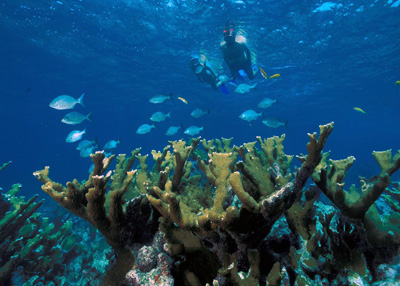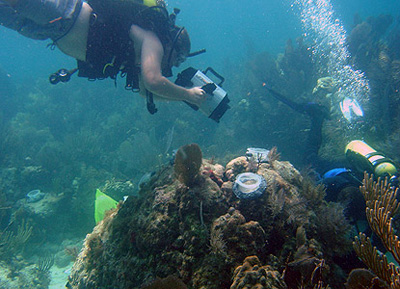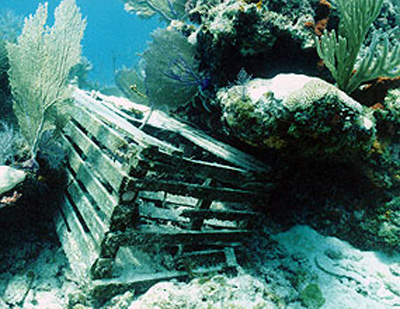
Biscayne Bay protection efforts not easy
HOMESTEAD, Fla. — Conserving a national park with a fragile ecosystem is no easy feat. It is especially so when the park is 95 percent underwater.
Biscayne National Park spans 172,000 acres of South Florida and is home to the beginning of the third-largest coral reef in the world, as well as three other ecosystems: a mangrove forest that makes up the mainland portion of protected area, the southern expanse of Biscayne Bay and the northernmost islands of the Florida Keys.
 |
Coral reefs, such as Elkhorn Reef (pictured), are susceptible to damage (Photo courtesy of the National Park Service, photo by John Brooks). |
One of the largest problems facing Biscayne National Park, headquartered on the shore of the bay here and about an hour south of downtown Miami, is vessel groundings and the subsequent damage caused to coral reefs and sea grass beds. The Damage Recovery Program at Biscayne works to repair damage to the marine habitats affected by such accidents.
“It is very difficult to protect the park because it is such a large area,” said Amanda Bourque, biologist and Damage Recovery Program manager. “Our Visitor Protection Division patrols the water, but even then generally not everything is taken care of.”
Bourque said that there are approximately 200 reported groundings every year, as well as several that go unreported.
“The lack of education amongst boaters is very high,” she said. “If they were better aware of their navigational systems and the waters, this wouldn’t be such a problem.”
Under the Parks System Resource Protection Act, any person who destroys, causes the loss of, or injures any park system resource is liable for costs and damages resulting from such destruction, loss or injury. When vessel grounding damage occurs, Bourque and two technicians work closely to map the injured area, then build an insurance claim to recover funds from the responsible party (the owner of the boat at fault).
|
Divers at Biscayne National Park monitor coral reproduction and settlement (Photo courtesy of the National Park Service, photo by Richard Curry). |
 |
Last summer, Biscayne’s resource management staff completed a two-week project that removed abandoned lobster and crab traps from coral reefs. Left alone, the litter could have harmed valuable reef organisms as well as crushed the overall reef structure.
The length of underwater restoration varies depending on the severity of the injury, with coral reefs being the hardest to repair. Complete restoration of an injured reef could last anywhere from a period of years to centuries. Currently, Bourque and her team are scheduled to begin a sea grass restoration project, which she predicts will take six months to complete.
Last year, The Miami Herald reported that Richard Curry, science and research coordinator at Biscayne National Park, has spent the past 15 years operating a team of volunteers, figuring out ways to grow coral polyps in the laboratory and even in underwater labs in the field.
Curry’s research efforts have succeeded in keeping the corals alive in the laboratory but not in the field. Until the lab-grown polyps can survive in their natural habitat, Bourque and her restoration team continue to monitor completed projects to ensure no new damage has occurred.
Conservation efforts also suffer from shortages in staffing. At Biscayne, the National Park Service budget cuts in recent years have translated into a reduction of nearly half the number of patrols assigned to keep an eye on park resources. The Visitor Protection Division at BNP consists of seven to eight positions, though Bourque said that not all the positions are filled at this time.
 |
Abandoned traps can harm reef organisms if left to break apart amongst the reef (Photo courtesy of the National Park Service, photo by Richard Curry). |
Development around the boundary of the park is another problem the staff encounters. The most recent infringement of park boundaries was discovered in the form of an island and causeway illegally built off the coast of Palmetto Bay on park-protected waters and coastline. The total cost to remove the island was $85,000, paid for by boater’s fines.
“The island goes back a while, and there have been several steps to the removal process,” Bourque said. “First we had to remove all of the upland structures, then plant hammock trees and mangroves to replace the ones that had been chopped down.”
From vessel groundings to man-made islands, the staff at Biscayne has their hands full every day on the job. And it is their dedication that keeps the park a beautiful place for visitors to enjoy.
For More Information
- Potential volunteers interested in Biscayne National Park conservation projects may contact the park’s volunteer coordinator at 305-230-1144, ext. 3035.
- Volunteer applications may be found online at http://www.nps.gov/bisc/supportyourpark/volunteer.htm.

Comments are Closed